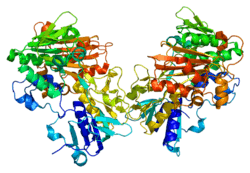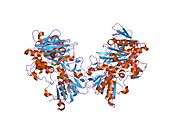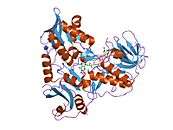AIFM1
Apoptosis-inducing factor 1, mitochondrial is a protein that in humans is encoded by the AIFM1 gene on the X chromosome.[3][4] This protein localizes to the mitochondria, as well as the nucleus, where it carries out nuclear fragmentation as part of caspase-independent apoptosis.[5]
Structure
AIFM1 is expressed as a 613-residue precursor protein that containing a mitochondrial targeting sequence (MTS) at its N-terminal and two nuclear leading sequences (NLS). Once imported into the mitochondria, the first 54 residues of the N-terminal are cleaved to produce the mature protein, which inserts into the inner mitochondrial membrane. The mature protein incorporates the FAD cofactor and folds into three structural domains: the FAD-binding domain, the NAD-binding domain, and the C-terminal. While the C-terminal is responsible for the proapoptotic activity of AIFM1, the FAD-binding and NAD-binding domains share the classical Rossmann topology with other flavoproteins and the NAD(P)H dependent reductase activity.[5]
Three alternative transcripts encoding different isoforms have been identified for this gene.[4] Two alternatively spliced mRNA isoforms correspond to the inclusion/exclusion of the C-terminal and the reductase domains.[5] A pseudogene that is thought to be related to this gene has been identified on chromosome 10.[4]
Function
This gene encodes a flavoprotein essential for nuclear disassembly in apoptotic cells that is found in the mitochondrial intermembrane space in healthy cells. Induction of apoptosis results in the cleavage of this protein at residue 102 by calpains and/or cathepsins into a soluble and proapoptogenic form that translocates to the nucleus, where it effects chromosome condensation and fragmentation.[4][5] In addition, this gene product induces mitochondria to release the apoptogenic proteins cytochrome c and caspase-9.[4] AIFM1 also contributes reductase activity in redox metabolism.[5]
Clinical significance
Mutations in the AIFM1 gene are correlated with Charcot-Marie-Tooth disease (Cowchock syndrome).[5][6] At a cellular level, AIFM1 mutations result in deficiencies in oxidative phosphorylation, leading to severe mitochondrial encephalomyopathy.[4] Clinical manifestations of this mutation are characterized by muscular atrophy, neuropathy, ataxia, psychomotor regression, hearing loss and seizures.[7]
Interactions
AIFM1 has been shown to interact with HSPA1A.[8][9]
References
- ↑ "Human PubMed Reference:".
- ↑ "Mouse PubMed Reference:".
- ↑ Susin SA, Lorenzo HK, Zamzami N, Marzo I, Snow BE, Brothers GM, Mangion J, Jacotot E, Costantini P, Loeffler M, Larochette N, Goodlett DR, Aebersold R, Siderovski DP, Penninger JM, Kroemer G (Feb 1999). "Molecular characterization of mitochondrial apoptosis-inducing factor". Nature. 397 (6718): 441–6. PMID 9989411. doi:10.1038/17135.
- 1 2 3 4 5 6 "Entrez Gene: AIFM1 apoptosis-inducing factor, mitochondrion-associated, 1".
- 1 2 3 4 5 6 Ferreira P, Villanueva R, Martínez-Júlvez M, Herguedas B, Marcuello C, Fernandez-Silva P, Cabon L, Hermoso JA, Lostao A, Susin SA, Medina M (Jul 2014). "Structural insights into the coenzyme mediated monomer-dimer transition of the pro-apoptotic apoptosis inducing factor". Biochemistry. 53 (25): 4204–15. PMID 24914854. doi:10.1021/bi500343r.
- ↑ Rinaldi C, Grunseich C, Sevrioukova IF, Schindler A, Horkayne-Szakaly I, Lamperti C, Landouré G, Kennerson ML, Burnett BG, Bönnemann C, Biesecker LG, Ghezzi D, Zeviani M, Fischbeck KH (2012). "Cowchock syndrome is associated with a mutation in apoptosis-inducing factor". Am. J. Hum. Genet. 91 (6): 1095–102. PMC 3516602
 . PMID 23217327. doi:10.1016/j.ajhg.2012.10.008.
. PMID 23217327. doi:10.1016/j.ajhg.2012.10.008. - ↑ Kettwig M, Schubach M, Zimmermann FA, Klinge L, Mayr JA, Biskup S, Sperl W, Gärtner J, Huppke P (2015). "From ventriculomegaly to severe muscular atrophy: Expansion of the clinical spectrum related to mutations in AIFM1". Mitochondrion. 21C: 12–18. PMID 25583628. doi:10.1016/j.mito.2015.01.001.
- ↑ Ruchalski K, Mao H, Singh SK, Wang Y, Mosser DD, Li F, Schwartz JH, Borkan SC (Dec 2003). "HSP72 inhibits apoptosis-inducing factor release in ATP-depleted renal epithelial cells". Am. J. Physiol., Cell Physiol. 285 (6): C1483–93. PMID 12930708. doi:10.1152/ajpcell.00049.2003.
- ↑ Ravagnan L, Gurbuxani S, Susin SA, Maisse C, Daugas E, Zamzami N, Mak T, Jäättelä M, Penninger JM, Garrido C, Kroemer G (Sep 2001). "Heat-shock protein 70 antagonizes apoptosis-inducing factor". Nat. Cell Biol. 3 (9): 839–43. PMID 11533664. doi:10.1038/ncb0901-839.
Further reading
- Daugas E, Nochy D, Ravagnan L, Loeffler M, Susin SA, Zamzami N, Kroemer G (2000). "Apoptosis-inducing factor (AIF): a ubiquitous mitochondrial oxidoreductase involved in apoptosis". FEBS Lett. 476 (3): 118–23. PMID 10913597. doi:10.1016/S0014-5793(00)01731-2.
- Ferri KF, Jacotot E, Blanco J, Esté JA, Kroemer G (2001). "Mitochondrial control of cell death induced by HIV-1-encoded proteins". Ann. N. Y. Acad. Sci. 926: 149–64. PMID 11193032. doi:10.1111/j.1749-6632.2000.tb05609.x.
- Candé C, Cohen I, Daugas E, Ravagnan L, Larochette N, Zamzami N, Kroemer G (2002). "Apoptosis-inducing factor (AIF): a novel caspase-independent death effector released from mitochondria". Biochimie. 84 (2–3): 215–22. PMID 12022952. doi:10.1016/S0300-9084(02)01374-3.
- Castedo M, Perfettini JL, Andreau K, Roumier T, Piacentini M, Kroemer G (2004). "Mitochondrial apoptosis induced by the HIV-1 envelope". Ann. N. Y. Acad. Sci. 1010: 19–28. PMID 15033690. doi:10.1196/annals.1299.004.
- Moon HS, Yang JS (2006). "Role of HIV Vpr as a regulator of apoptosis and an effector on bystander cells". Mol. Cells. 21 (1): 7–20. PMID 16511342.
- Glass L (1976). "Classification of biological networks by their qualitative dynamics". J. Theor. Biol. 54 (1): 85–107. PMID 1202295. doi:10.1016/S0022-5193(75)80056-7.
- Andersson B, Wentland MA, Ricafrente JY, Liu W, Gibbs RA (1996). "A "double adaptor" method for improved shotgun library construction". Anal. Biochem. 236 (1): 107–13. PMID 8619474. doi:10.1006/abio.1996.0138.
- Yu W, Andersson B, Worley KC, Muzny DM, Ding Y, Liu W, Ricafrente JY, Wentland MA, Lennon G, Gibbs RA (1997). "Large-scale concatenation cDNA sequencing". Genome Res. 7 (4): 353–8. PMC 139146
 . PMID 9110174. doi:10.1101/gr.7.4.353.
. PMID 9110174. doi:10.1101/gr.7.4.353. - Susin SA, Zamzami N, Castedo M, Daugas E, Wang HG, Geley S, Fassy F, Reed JC, Kroemer G (1997). "The central executioner of apoptosis: multiple connections between protease activation and mitochondria in Fas/APO-1/CD95- and ceramide-induced apoptosis". J. Exp. Med. 186 (1): 25–37. PMC 2198951
 . PMID 9206994. doi:10.1084/jem.186.1.25.
. PMID 9206994. doi:10.1084/jem.186.1.25. - Susin SA, Lorenzo HK, Zamzami N, Marzo I, Brenner C, Larochette N, Prévost MC, Alzari PM, Kroemer G (1999). "Mitochondrial release of caspase-2 and -9 during the apoptotic process". J. Exp. Med. 189 (2): 381–94. PMC 2192979
 . PMID 9892620. doi:10.1084/jem.189.2.381.
. PMID 9892620. doi:10.1084/jem.189.2.381. - Daugas E, Susin SA, Zamzami N, Ferri KF, Irinopoulou T, Larochette N, Prévost MC, Leber B, Andrews D, Penninger J, Kroemer G (2000). "Mitochondrio-nuclear translocation of AIF in apoptosis and necrosis". FASEB J. 14 (5): 729–39. PMID 10744629.
- Joza N, Susin SA, Daugas E, Stanford WL, Cho SK, Li CY, Sasaki T, Elia AJ, Cheng HY, Ravagnan L, Ferri KF, Zamzami N, Wakeham A, Hakem R, Yoshida H, Kong YY, Mak TW, Zúñiga-Pflücker JC, Kroemer G, Penninger JM (2002). "Essential role of the mitochondrial apoptosis-inducing factor in programmed cell death". Nature. 410 (6828): 549–54. PMID 11279485. doi:10.1038/35069004.
- Ravagnan L, Gurbuxani S, Susin SA, Maisse C, Daugas E, Zamzami N, Mak T, Jäättelä M, Penninger JM, Garrido C, Kroemer G (2001). "Heat-shock protein 70 antagonizes apoptosis-inducing factor". Nat. Cell Biol. 3 (9): 839–43. PMID 11533664. doi:10.1038/ncb0901-839.
- Ye H, Cande C, Stephanou NC, Jiang S, Gurbuxani S, Larochette N, Daugas E, Garrido C, Kroemer G, Wu H (2002). "DNA binding is required for the apoptogenic action of apoptosis inducing factor". Nat. Struct. Biol. 9 (9): 680–4. PMID 12198487. doi:10.1038/nsb836.
- Roumier T, Vieira HL, Castedo M, Ferri KF, Boya P, Andreau K, Druillennec S, Joza N, Penninger JM, Roques B, Kroemer G (2003). "The C-terminal moiety of HIV-1 Vpr induces cell death via a caspase-independent mitochondrial pathway". Cell Death Differ. 9 (11): 1212–9. PMID 12404120. doi:10.1038/sj.cdd.4401089.
External links
- AIFM1 on the Atlas of Genetics and Oncology
- Human AIFM1 genome location and AIFM1 gene details page in the UCSC Genome Browser.



